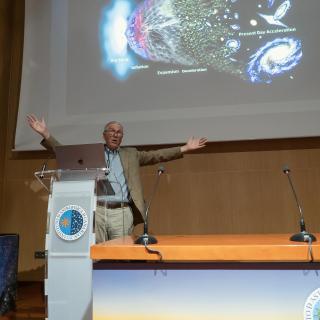José Guichard, Instituto Nacional de Astronomía, Óptica y Electrónica de México: ‘Con su instrumentación el GTC logrará avances en todos los campos de la Astronomía’
El ‘I Congreso Ciencia con el GTC’, que se clausura hoy en Granada y que reúne a más de 180 especialistas en Astrofísica, ha despertado el interés de la comunidad científica internacional por el Gran Telescopio CANARIAS (GTC). Así quedó claro en las intervenciones de los ponentes de las instituciones extranjeras participantes en la construcción y operación de este telescopio que, una vez finalizada su construcción en primavera de 2003, será el mayor telescopio del mundo.
Entre estas instituciones está la Universidad de Florida, que firmó un acuerdo de participación con el Instituto de Astrofísica de Canarias (IAC). Esta universidad aportará el 5% del presupuesto del telescopio y ha mostrado su intención de aumentar a un 10% su aportación final al proyecto. El IAC también tiene suscrito otro acuerdo con el Instituto de Astronomía de la Universidad Nacional de México (IA-UNAM), conjuntamente con el Instituto de Astrofísica, Óptica y Electrónica (INAOE) y Consejo Nacional de Ciencia y Tecnología de México (CONACYT). Estas instituciones mexicanas participarán con otro 5% en el presupuesto del telescopio.
El director del Departamento de Astronomía y profesor de Astronomía de la Universidad de Florida, Stanley F. Dermott, calificó al GTC como "un instrumentos excelente", que contará, una vez comience su operación científica en 2004, "con muy pocos competidores" en el panorama científico internacional. Dermott resaltó en su ponencia la importancia de la colaboración de su universidad con México y España, y subrayó la colaboración entre estos países en la formación de sus estudiantes. "Es muy importante que los investigadores y estudiantes postdoctorales participen en grupos internacionales como los que se formarán en colaboración con el GTC", concluyó.
De la misma opinión es José Guichard, director del Instituto Nacional de Astronomía, Óptica y Electrónica de México. Según este astrofísico, aunque ya existen varios telescopios operando en su país, el GTC "está sin duda entre uno de los proyectos más importantes". Un interés que, en su opinión, ha calado en la comunidad científica internacional. Desde el punto de vista científico, Guichard opina que "con la instrumentación asociada al GTC, este telescopio logrará avances importantes en todos los campos de la Astronomía, desde la planetaria hasta la formación y evolución de galaxias". Estos avances se deben, en palabras del astrofísico mexicano, al hecho de que el GTC "contará con instrumentos que van a ser únicos en su tipo y con los que no cuentan otros telescopios".
El GTC, ya en una fase avanzada de su construcción, quedará instalado en el Observatorio del Roque de los Muchachos, del IAC, en la isla canaria de La Palma, y se espera que la plena operación científica comience en 2004. El ‘I Congreso Ciencia con el GTC’ ha sido organizado por el Instituto de Astrofísica de Canarias (IAC), el Instituto de Astrofísica de Andalucía (IAA) y la empresa pública GRANTECAN, que gestiona la construcción del Gran Telescopio Canarias.
Programa completo de la conferencia


